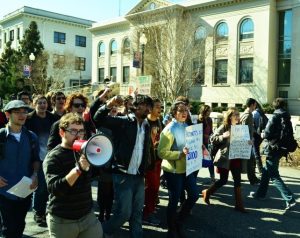By Marisa Allison
These days you don’t have to look too far on any college or university campus in the Washington, D.C. metro area (or in any other metro area of the U.S., for that matter) to see adjunct and other contingent faculty organizing for better working conditions. The hub and testing ground of what has become the modern movement strategy (the metro organizing strategy) began with colleges and universities in the Washington, D.C. metro area and has spread to institutions in Boston, Los Angeles, and Seattle.
Part-time faculty at George Washington University, American University, Georgetown University, Howard University, the University of the District of Columbia in Washington, D.C., and Montgomery College and the Maryland Institute College of Art in Maryland have all won collective bargaining rights by joining Service Employees International Union Local 500’s Coalition of Academic Labor. The burgeoning academic labor movement creates a rare and important opportunity for sociologists both inside and outside the academy to consider what role sociologists should play as the professoriate and institutions of higher education transform.
The business of higher education is no stranger to the precariously employed, though many would be surprised to find that the majority of the precariously employed in higher education reside in the faculty ranks. Contingent faculty, as they are broadly known, are given many different titles (adjunct, lecturer, term faculty, instructors, postdocs, teaching assistants, etc.), yet together they now make up the majority of faculty on U.S. college and university campuses.
Nationally, adjunct and other contingent faculty are estimated to make up 75 percent of the total faculty in higher education, according to the U.S. Department of Education’s 2009 Fall Staff Survey. More frightening than the numbers of contingent faculty in U.S. higher education are the employment conditions they face, mirroring conditions historically encountered by the precariously employed in other industries: earning less than a living wage, having little to no employee benefits, lack of job security, lack of representation on faculty senates, and little to no advancement opportunities. The plight of contingent faculty is now slowly being revealed.
During the 2012-2013 academic year, two colleagues and I in the Public Sociology Association at George Mason University (GMU) took up the cause of contingent academic labor rights on our campus. GMU is no stranger to this phenomenon, reporting that 71 percent of their faculty for the 2012-2013 academic year are contingent faculty. Working with contingent faculty members at GMU, we constructed and distributed a campus wide survey to comprehensively assess the working conditions of the approximately 1,600 contingent faculty on Mason’s campuses. That survey is now available for open-source use to anyone who wants to understand the working conditions of contingent faculty at their institution. The survey instrument and report can be accessed on our project website: contingentfacultystudy.wordpress.com.
The report was publicly released in early October 2014 with findings that have shocked the community, including low levels of compensation in addition to significant amounts of uncompensated work; minimal hiring requirements and being hired right before a semester begins; a lack of resources and access to a private space to meet with students along with few training opportunities to accommodate students with special needs; and high percentages of contingent faculty who provide their own resources to prepare and carry out their courses. GMU, however, is no different than most other institutions of higher education as the results found in this research mirror those found in national surveys of contingent faculty. The university has since responded and is taking action to address many of these problems, which is encouraging.
Though there are many ways sociologists can help the advocacy efforts of contingent faculty, one of the best roles sociologists can play in support of the academic labor movement is by using the skills we have as social scientists to conduct research and advocate for the collection of more and better information concerning academic labor at the institutional and national levels. Determining how institutional research offices at your current university or alma mater collect faculty data and encouraging them to include contingent faculty in their collection efforts would help improve the quality of existing data. Similarly, if the human resource office at your institution conducts a faculty work/life survey, advocate for the inclusion of part-time and other contingent faculty participation in its construction and implementation.
On the national level, until 2003, the U.S. Department of Education collected detailed information about the academic workforce through the National Study of Postsecondary Faculty. With inadequate funding, collection efforts ceased at a time when national data has been needed most. Joining other voices in our community, and calling for the resumption of these collection efforts would greatly assist the advocacy efforts within the movement.
Afterword: The authors of the GMU contingent faculty working conditions report are far from the first Washington D.C. metro sociologists to address contingency employment in higher education.
Check out the work done by fellow sociologists: Dr. John Curtis, Director of Research at the American Sociological Association; Dr. Esther Merves Director of Research at the New Faculty Majority Foundation; and Dr. Rita Kirshstein, Director of the Delta Cost Project and Managing Director at American Institutes for Research.

